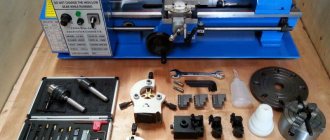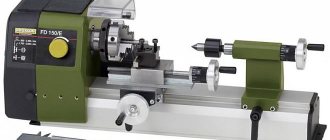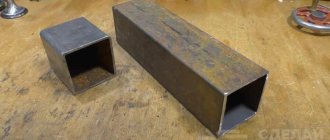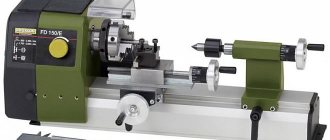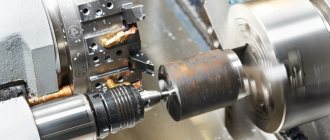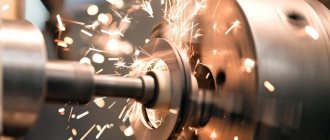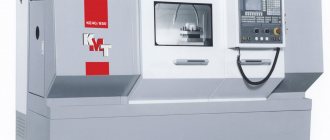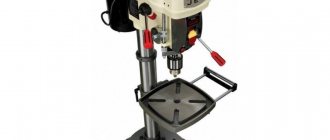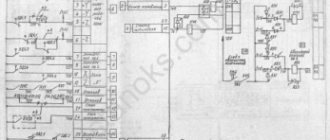In conditions of limited space for a home craftsman, the best option is a metal lathe for the garage in a basic or advanced configuration. There are a lot of manufacturers and modifications of equipment on the modern market. Therefore, below are recommendations from experts on choosing a mini-machine for metal turning.
Metal lathe for garage
How convenient is it for home?
The main advantages of machines for garages can be considered versatility and compactness. Thanks to its small size, the equipment can be easily installed in confined spaces.
Often such machines are placed in garages or technical rooms of a private home. The equipment will be appreciated by craftsmen who like to do everything with their own hands.
The garage machine is a smaller version of professional installations. It perfectly performs all the required functions. For household use this is quite enough.
Classification of turning units
Lathes were created for processing cylindrical workpieces.
This shape is given to the part as a result of processing the outer surface. The operation in this case is called turning.
In order to process the inner surface, boring is performed.
The following types of turning units are used in production cycles:
- revolver;
- screw-cutting;
- multi-spindle;
- milling
- with CNC.
For small-scale and piece metal production, it is customary to use a “Universal” mini lathe.
Mini installations of this series are created specifically for use in individual and small-scale production.
If you need to create a full-fledged enterprise for processing metal products, you have to use units of different profiles and purposes, including a milling machine that copes with the task perfectly.
The Chinese CNC turret machine is used in the implementation of the most complex projects.
Video:
However, there is no desktop version with adequate performance and reliability on the market yet. The screw-cutting lathe has wide functionality.
Currently, such mechanisms are successfully produced by hand.
However, we have to admit that in terms of their reliability and durability they cannot compete with factory-produced items.
Benchtop screw-cutting lathe
The current economic model stimulates the formation and development of small businesses.
In addition to this, a certain number of people are engaged in folk crafts and such craftsmen very often need a tabletop machine
on metal.
In such a situation, the turning-screw-cutting unit was highly appreciated by the craftsmen. A mini machine of this type is produced by companies whose headquarters are located in different countries.
When choosing a specific model, you need to pay attention to the brand under which the unit is manufactured. Tabletop mini lathe-screw-cutting unit is used to perform the following processing operations:. Tabletop mini lathe-screw-cutting unit is used to perform the following processing operations:
Tabletop mini lathe-screw-cutting unit is used to perform the following processing operations:
- turning and boring surfaces;
- hole reaming;
- processing of end surfaces;
- thread cutting;
- countersinking;
- drilling
The desktop precision mini screw-cutting lathe is considered to be one of the main ones in the production of mechanical and electronic watches.
The production of measuring instruments requires the use of high-precision equipment.
Video:
A screw-cutting lathe is used here to process miniature shafts and bushings.
A desktop CNC milling machine produces cabinet parts.
Lathes of the “Universal” series
When getting acquainted with the line of Universal table lathes, you should pay attention to the versatility of a particular model
The first and very important advantage over professional equipment of this class is that the mini unit operates from a 220V household power supply.
The first and very important advantage over professional equipment of this class is that the mini unit operates from a 220V household power supply. The weight of the unit, depending on the model, ranges from 30 to 60 kg. Some craftsmen install the “Universal” in the home workshop
The machine makes virtually no noise during operation
Some craftsmen install the “Universal” in their home workshop. The machine makes virtually no noise during operation
The weight of the unit, depending on the model, ranges from 30 to 60 kg. Some craftsmen install the “Universal” in their home workshop. During operation, the machine makes virtually no noise.
The “Universal” mini machine is used to perform the following technological operations:
- boring;
- sawing;
- drilling;
- grinding;
- milling.
The third model of the “Universal” unit is equipped with a function that allows you to change the movement of the caliper without stopping the rotation of the spindle.
Plus, the machine can process workpieces with high precision. In particular, according to the parameters of roughness, non-roundness and taper.
The maximum diameter of the workpiece that can be processed on the Universal machine is from 90 to 150 mm.
In the first case, the workpiece is installed above the bed, in the second - above the support.
Kinds
For the garage, both mini-machines and floor-mounted ones are purchased. It is necessary to build on the required characteristics and free space.
Mini metal machines
A mini-machine is a device that belongs to the desktop type. Their weight may be 15-200 kg. For a garage, it is best to buy a model weighing about 50 kg. Such a device will be easy to install in the required location or move if necessary.
It is not advisable to purchase the smallest models. There is a high probability that they will be unstable, which is why they will begin to produce strong vibration during operation. This will affect the quality of the parts.
Floor options
In the case of floor-standing machines, the choice is less wide, since their weight and cost are much higher. There are several expert-tested models that are suitable for installation in a garage.
Some tips and tricks
If there is a need to purchase a lathe for work at home, then you should not mess with equipment that has already been used.
Even if at home everything in such a lathe looks perfect at first glance, during its subsequent operation a variety of hidden defects may be revealed.
Video:
When purchasing a lathe, it is important to check the performance and declared characteristics of the device. To do this, you should run the equipment in various operating modes, and also check the complete absence of backlash in all moving parts
For all lathes, an important indicator is accuracy, which must be at a high level.
Currently, the market offers a huge selection of this class of devices for both home and industrial production. When purchasing it, you should not chase the price; it is better to opt for a proven and well-known brand.
Benchtop lathes open up enormous opportunities for the home craftsman.
By what criteria to choose, how to choose the best?
The choice must be based primarily on the tasks that the machine must perform. After this, the reliability of the equipment, dimensions and technical characteristics are studied.
Specifications
The following characteristics are important for a lathe:
- Power . This parameter determines the processing speed of the workpiece. For domestic use, 500-750 W is sufficient.
- Type of food . The equipment can be powered by 220 or 380 volts. For the second type, it is necessary to install a separate power supply line, which cannot always be done in a garage.
- Engine's type . It is advisable to choose asynchronous, as it has a longer service life.
- Transfer type . There is a belt and a gear.
- Reverse . This is the ability to switch the direction of rotation. In some cases this function is very important.
- Rotation frequency . It is necessary to select one for each metal, so it is desirable to have several operating modes.
- Additional equipment . You need to select it for specific tasks.
- Division of the limb . The accuracy of processing depends on this. The smaller the division, the better.
- Housings . The presence of protective elements makes work safer.
Materials and build quality
There are models of domestic and foreign production on sale. But almost everyone still gathers in China. Most people prefer to choose domestic machines, since it is easier to find spare parts for them in the event of a breakdown.
Important!
It is desirable that the gears are made of metal or caprolon. In some machine models, many parts are made of plastic, which is why they wear out quickly.
Size
It is necessary to allocate space for the lathe in advance and select a table that can withstand heavy loads. The dimensions of the equipment completely depend on the size of the parts being processed.
In most cases, a center-to-center distance of 40 cm is enough to fasten the workpieces. In addition to the length, you should also pay attention to the mounting height, since this indicator determines the maximum diameter of the product.
Classification
Lathes are produced for industrial production and for home use. Industrial units usually have large dimensions, significant weight (more than 1 t), and high accuracy. They operate on a 380 V mains voltage and cut large workpieces (500 mm or more in length).
Household equipment is not designed to handle large, heavy workpieces. Their length does not exceed 1000 mm. The lathe is located in a regular garage or shed. It operates on 220 V, has low power and cutting accuracy. Average weight 50-80 kg.
According to the type of operations and design, machines are divided into:
- Screw-cutting machines – designed for cutting internal and external threads, boring, end processing, countersinking. The most popular type.
- Boring - drill, bore holes, cut threads, grooves, countersink. Refers to universal equipment.
- Drilling - designed for creating holes of different diameters in workpieces and cutting threads.
- Grinding – used for external and internal grinding of parts using grinding discs, cutting workpieces, sharpening tools.
- Turning and milling - allow milling, drilling, thread formation, sharpening of parts, boring using metal-cutting cutters installed in the milling head.
- Universal machines with numerical control - perform various metal cutting tasks using customized programs. They are accurate, productive and easy to use.
Household machines are floor-standing and table-top. Floor-standing equipment has a frame that is mounted on vibration absorbers or a separate foundation. The unit weighs 200-400 kg or more, has a length of 1-1.5 m. It processes workpieces up to 750 mm long and up to 300 mm in diameter.
A tabletop machine is placed on a heavy table or bed. It has smaller dimensions and weighs up to 200 kg. Designed for processing small parts and workpieces. Light models vibrate and therefore do not provide high precision work.
Depending on the location of the spindle, lathes can be horizontal or vertical. Most models have a horizontal feed of the part on the spindle for further processing. Vertical – used for turning large workpieces of large diameter and short length.
How to build it yourself
A normal machine costs at least 50,000 rubles. If you assemble it yourself, this amount will be significantly reduced.
Attention. To make a homemade lathe, it is advisable to use standard drawings. There are all the dimensions of the parts and the order of assembly.
These drawings can be improved. For example, it is worth adding an emergency shutdown button, a thermal relay that protects against overheating, and a protective casing.
Selection of parts
Certain elements of the device will have to be purchased assembled, such as the motor and clamp. Some are purchased separately and ordered in workshops, where they will be made to the required dimensions. The better the steel used, the longer the machine will last.
Base
The best choice would be to use a cast frame from an old non-working machine. The stability of the unit depends on the base. As an alternative, you can weld a frame from channels or profile pipes. You cannot take wood, as it will not be able to withstand the workload.
Electric motor and transmission
For the engine, you can use a device from an old washing machine or other household appliances that have sufficient power. It is also worth considering purchasing a new engine, since the price is not too high.
It is better to use a belt drive. It is much easier to assemble. Also, when using a belt directly on the shaft, there is less impact, and this significantly increases the service life.
Master and slave centers
These two nodes are placed on the same axis. There is also a type of machines that have one leading center. The follower must be placed on the tailstock (it can be rotating or stable). The sharpened end of the bolt is suitable for manufacturing.
Varieties
There are many types of lathes
Before purchasing, it is important to familiarize yourself with the features of each type in order to make the right choice.
Tabletop for home workshop
A small machine is fixed on a special table. It is lightweight and small in size, but allows you to perform a large number of operations. In addition to external processing, drilling and boring can be performed. Its advantages are low cost and energy consumption. There is almost no noise during operation.
Household, miniature (mini), small-sized
The weight of such machines often does not exceed 50 kg, but the technical characteristics of many models are not inferior to large-sized analogues. The bed is made mainly of cast iron - this reduces vibration during operation. The working diameter of the chuck is 50–100 mm, the spindle speed is 100–3800 rpm, and the motor power varies from 0.55 to 2.25 kW.
Screw-cutting
A common group of lathes of various modifications. They were popular back in Soviet times in large industries. They differ in dimensions, length and diameter of the processed parts. Modifications 16K20, 1K62 are often found in factories.
Automatic with cross feed
They are used in mass production for various operations with small parts, including processing of shaped surfaces. They are also used for turning products made of copper, brass, and alloy steel.
Universal
A common group of machines that are found in serial and mass production. This includes a screw-cutting lathe. Such equipment is distinguished by a wide range of modes (spindle speed, tool feed speed), as well as the ability to perform work of various profiles.
Classification of universal machines:
- Heavy - they can process large parts with a diameter of 1600–4000 mm.
- Up to 15 tons - designed for processing parts with a diameter of 600–1250 mm.
- Up to 4 tons - the maximum permissible workpiece diameter is 500 mm.
- Lightweight - for working with small products with a diameter of 100–200 mm.
Universal units also include turret lathes. They are intended for mass and serial production of parts from rods. The main thing that distinguishes it from a screw-cutting lathe is the presence of a turret head, to which several tools can be attached at once in the sequence necessary for work.
Mobile
Portable machines are compact in size and have a powerful design with hydraulic or pneumatic drive. Depending on the modification, it is possible to process external and internal cylindrical surfaces, pipes, flanges, and grooves. The machine is attached to the edge of the workpiece.
Features and Benefits:
- Easy installation and fixation of the part.
- Performing operations in hard-to-reach places.
- Possibility to use additional devices.
- High precision and processing quality.
Unusual
There are unusual types of lathes found in industry. This is expensive, narrow-profile equipment, which is serviced by highly qualified workers.
These include:
- Multi-spindle - allows you to process several parts at the same time. Used in mass production conditions.
- Semi-automatic copy machines - perform complex operations using several tools.
- Lathes - designed for parts whose diameter is many times greater than their height (pulleys, flanges, wheels).
- Carousel - industrial machines for precision processing of large parts.
- Backing - designed for sharpening cutting tools (mills, taps, reamers, countersinks).
Manual
The group combines types of manually controlled lathes (not CNC). They are not equipped with automation; the turner performs all actions manually. The tailstock is moved and the quill is fed by the worker without the help of additional mechanisms.
Only the feeding of the cutting tool is automated. Manual machines are gradually being replaced by analogues with CNC, automatic and semi-automatic machines.
Micro
Equipment is limited to a weight of 30–35 kg. The machines are used for small-scale work in the home workshop. They are powered mainly from a 220 V outlet. Low power consumption and lack of noise allow you to work without disturbing your neighbors.
Safety precautions
When working on a lathe, it is mandatory to comply with safety precautions:
- Always check the reliability of fastening the part and the cutter.
- Remove chips in a timely manner.
- Monitor the drainage of coolant.
- Make sure there is grease in the center of the tailstock.
- It is forbidden to remove shavings by hand or blow them away.
- Do not stop the cartridge with any objects or hands.
- It is imperative to use steady rests if the length of the workpiece is greater than its twelve diameters or when working at high speeds.
- When processing tough metals, it is necessary to use special cutters.
- It is prohibited to place objects on the machine.
- Do not throw the device while it is running.
- It is necessary to use chip guards when working with brittle metals.
- Do not lubricate with a cloth.
A lathe is a very useful device in the arsenal of a home craftsman. But before purchasing, you should decide on the required characteristics of the device. You can also assemble it yourself. The main thing is to follow safety precautions while working so as not to harm yourself and others.
Computer numerical control
(X,Y,Z){\displaystyle (X,Y,Z)_{0}} - fixed coordinate system
(X,Y,Z)d{\displaystyle (X,Y,Z)_{\text{d}}} - coordinate system associated with the place of fastening of the part or with its base surfaces, relative to which the surface being processed is described
(X,Y,Z)and{\displaystyle (X,Y,Z)_{\text{and}}} - coordinate system associated with the tool attachment point, relative to which its cutting surface and the position of the cutting edge are described
(τ,ν,β)k{\displaystyle (\tau ,\nu ,\beta )_{k}} - a movable trihedron (Frenet trihedron) associated with the cutting edge and determining its position relative to (X,Y,Z) and{\displaystyle (X,Y,Z)_{\text{and}}}
(τ,ν,β)i{\displaystyle (\tau ,\nu ,\beta )_{i}} - a movable trihedron associated with surface points and determining their position in the coordinate system (X,Y,Z)d{ \displaystyle (X,Y,Z)_{\text{d}}}.
Mathematically, the processed surface is obtained by the mutual movement of two trihedrons - (τ,ν,β)i{\displaystyle (\tau ,\nu ,\beta )_{i}} associated with the surface of the part, and (τ,ν,β)k {\displaystyle (\tau ,\nu ,\beta )_{k}} associated with the cutting edge of the tool. The elements of the matrix kAi{\displaystyle {}^{k}A_{i}} determine the movement of the cutting edge relative to the software specification of the surface, and Ai{\displaystyle {}^{\text{and}}A_{i}} is the position of the cutting edge in coordinate system (X,Y,Z){\displaystyle (X,Y,Z)} and dAi{\displaystyle {}^{\text{d}}A_{i}} - position of programmable surface reference points in the workpiece coordinate system , Ad{\displaystyle {}^{0}A_{\text{d}}} and 1Ai{\displaystyle {}^{1}A_{\text{u}}} - position of coordinate systems (X,Y,Z )d{\displaystyle (X,Y,Z)_{\text{d}}} and (X,Y,Z)i{\displaystyle (X,Y,Z)_{\text{u}}} regarding (X,Y,Z){\displaystyle (X,Y,Z)_{0}}.
Universal milling
Metalworking machines of this type have a spindle placed horizontally and are intended for cutting workpieces that are relatively small in size and weight. Such equipment cuts parts with tools of various types: disk, cylindrical, angular, end, shaped and end. Such machines, regardless of the chosen modification, allow you to process the surfaces of metal workpieces vertically, make horizontal chamfers and screw threads, grooves and corners in parts. If additional operations are required related to dividing or helical movement of the workpiece under the edge of the cutter, the actions are performed manually, using additional equipment that is mounted on the table.
When choosing such models, you need to take into account that their design is quite complex. The main mechanisms are located on the frame, with the spindle assembly and gearbox located inside the housing. The mandrel with the cutting tool is held by a trunk with pendants. The console with the gearbox mechanism moves along vertical guides. The rotating mechanism, designed to rotate the table around its axis by 45 degrees, is located on the console guide rails. Thanks to this engineering solution, a table with a fixed part can be directed horizontally in relation to the cutting edge of the metal tool, at any angle.
Horizontal milling
This type is one of the most common. This option is very simple in practical work and technical maintenance. It is a mechanism frame with a horizontal spindle on which there is a cutter, a gearbox and a table that moves horizontally, vertically and perpendicularly. Machines of this type are not only simple, they are also reliable - which makes it possible to choose them as equipment for any repair shop.
Horizontal milling machine
Widely versatile
These milling machines have an additional spindle head located on a movable trunk. Thanks to this engineering solution, the cutting tool can be rotated at any angle relative to the part in two different planes. Such products are capable of cutting metal both separately and simultaneously, using two spindles with an installed tool. A greater degree of versatility of such metal machines is given by the installation of an overhead milling head, which is mounted on a rotary one. This type of metal machine allows not only to mill a workpiece, but also to drill, countersink or boring a part, so they are often included in the list of those considered when choosing equipment.
In modifications of the machines, there is no console; instead, a carriage moves along the guides of the bed, allowing the table and auxiliary equipment to be attached. Such equipment is universal; it is chosen for metal processing at experimental enterprises and tool shops.
Vertical cantilever milling machines
These metal machines, unlike previous models, have a vertical spindle placement. Some modifications allow you to move the spindle along the axis and make horizontal turns, which significantly expands the functions of the machine. The cutter is inserted into a special cone in a mandrel. Metal milling on such machines can be done not only by lifting the table, but also by using vertical operations with a cutting tool. Thanks to the use of a special mandrel, processing of products on this type of equipment can also be done with disk cutters.
Vertical milling machine
Consoleless machines
Such metal machines make it possible to mill vertical, horizontal, inclined surfaces and grooves and were designed for metal work on workpieces of large dimensions and significant weight. On such machines, there is no console; the movement of the slide and table is carried out along the guides of the frame, fixed in the foundation.
Thanks to an engineering solution, the design of milling equipment, which has high rigidity, makes it possible to cut metal with greater accuracy than cantilever-type machines and process large-sized workpieces with a large mass. On such machines, the spindle head, which is also a gearbox, moves along guides. The spindle with the sleeve moves along the axis to set the metal cutter to the desired size.
Cantileverless milling machine
Engine selection
When purchasing a finished machine, you need to pay special attention to the engine. The existing engine fully corresponds to the description in the instructions, which specify the permissible loads. First you need to decide on the needs and area in which the machine will be used.
Asynchronous
An induction motor is designed to convert alternating current electrical energy into mechanical energy. The name of this motor includes its purpose, “asynchronous” means “non-simultaneous”.
It is indicated that in asynchronous motors the rotation frequency of the stator magnetic field always exceeds the rotor rotation frequency. The operation of an asynchronous motor occurs from an alternating current network. The induction motor has either an aluminum or cast iron frame. The stator winding is located in the slots of the stator core.
The ends of the winding phases are brought out through a hole in the frame into a box, which consists of a housing, an adapter pipe and a cover. This class of engines has a wide power range. They are chosen mainly because they have high power with relatively small sizes, the rotation speed is high, and asynchronous motors are reliable.
Collector
The commutator motor assumes in its design a rotor position sensor and a current switch in the windings, which is one and the same device - a brush-commutator unit.
An electric current entering the armature windings provokes the appearance of an electric field, which, on the one hand, has a south pole, and on the other hand, a north pole. The current through the windings gradually passes from one winding to another, the motor shaft rotates together with the armature, but only as long as voltage is supplied to it.
terms of Use
Creating optimal conditions for the operation of small-sized equipment is the key to its long and trouble-free operation. This requires compliance with a number of conditions.
- Maintaining the temperature in the workshop from 1 to 35°C. After being in sub-zero temperatures, the machine must be warmed up for 8 hours.
- Carrying out humidity control. It should not exceed 80%.
- Periodically change the oil in the box.
- Regular inspection of electrical wiring and engine, removing accumulated dirt from them.
- Cleaning the surface of the machine from chips and dust after finishing work.
Safety precautions
- Wear protective glasses and clothing that fits close to the body.
- The presence of foreign objects in the work area is prohibited.
- Control and switch handles are located outside the hazardous areas of the machine.
- The reliability of fastening the workpiece in the clamp is monitored.
- Do not remove chips by hand or stop the chuck while moving.
- The coolant level, the integrity of the electrical wiring and the absence of damage to the housing are constantly monitored.
Violation of these rules may result in injury to your hands and eyes. Neglect of safety precautions carries the risk of more serious injuries and death.
In-demand products
When starting your turning business, you need to find out which turning products are in greatest demand. Starting to produce batches of parts for sale means risking being left with unsold products. Everything that is made in large quantities is produced by large enterprises.
At the initial stage of business on a lathe, customers will tell you what to produce. You need to tune in to the individual production of parts for repairing cars and household appliances.
Gradually, people will learn about the opportunity to turn a shaft or other part for repair at an affordable price in a lathe shop nearby. Many people have equipment at home for which they have stopped producing spare parts, but it is working and it is a pity to throw it away because of a broken axle or other part. Similarly, a bolt or washer for a car can be bought at a car dealership, but the price is steep.
Large enterprises are reluctant to take on small orders from outside. A calculation is made for workshop costs:
- hourly cost of machine operation;
- payment for electricity;
- wages of the main worker;
- wages of auxiliary workshop workers;
- depreciation charges for equipment.
Typically, large enterprises have DIP200 and even larger turning units. They consume a lot of electricity, regardless of the size of the part. The machine operator works according to the technology and drawing developed by the engineering staff of the enterprise. Additional costs exceed workshop costs by 3-5 times. The result is astronomical prices for the manufacture of parts.
When developing business ideas, you should also take into account customers with small batches of parts. Builders, auto mechanics, furniture makers and other specialists will appear quite quickly. They will need to make adapters for heating pipes, cut threads and bore nuts. Furniture makers who are accustomed to working with wood cannot grind the studs and make nuts for them themselves. If the cost of production from a turner working nearby is lower than purchased materials, they will willingly go to a small workshop.
It is difficult to predict which parts will be in demand. Each city, and even microdistrict, has its own needs for small things made on a lathe.
Professional quality equipment
Professional machines in the premium price segment are equally well suited for both home workshops and industrial use.
JET JWDP-12 716000M
A universal machine for working with wood and metal products. It has a V-belt drive that allows you to adjust the spindle speed. Equipped with a cast iron table with grooves for securing the vice.
PROMA E-1720FVL/400
Floor-mounted installation equipped with a cone for clamping tools. The desktop rotates 360 degrees and has a tilt angle of 45 degrees. It has a regulator of drilling depth and spindle speed. Has a spindle speed indicator and a light.
Encore Corvette-441 94410
Vertical drilling machine equipped with an asynchronous motor and a coolant tank. Has an overload fuse and a scale to control vertical movement.
Dewalt Dwe1622k
It has small dimensions and a comfortable plastic non-slip handle. Provides fast drilling in metal. Supports drills up to 50mm in diameter.
Room lighting
When working with sharp tools that rotate at high speed, you must follow safety regulations. First you need to clearly see everything you do. Proper lighting will create comfortable working conditions for the carpenter. If there is insufficient natural light, additional light is provided above the workbench. If a do-it-yourself carpentry will be located in a garage without windows, then the lighting should be combined. Fluorescent lamps are added to conventional incandescent lamps.
The light should be even and not flickering. Lighting should not create shadows on the product; they can visually distort the proportions and sizes of parts. Since there is a lot of electrical equipment and lamps in the workshop, think in advance about the number of sockets and automatic shutdown in case of overload. This is not always good, especially when work is done on machines. Adjusting the loads on electrical and lighting devices falls on the shoulders of the master. The best option to ensure safe operation of the workshop is to consult an electrician. This will save you from problems in future work.
Rating of lathes
The range of manufacturers includes universal models, specialized machines for wood or metal. Our experts performed testing and compared the experimentally obtained characteristics with the parameters stated in the documentation. When compiling the rating, the opinions of users and professional turners were taken into account
Particular attention was paid to the following characteristics:
- Engine power – machines equipped with three-phase electric motors are capable of working with large metal workpieces. Motors powered from a 220 V network are less powerful and have a smooth feed, which limits the range of tasks they can solve;
- Weight – Heavy equipment provides maximum stability but is designed for stationary use. Lightweight models can be moved, and a workbench can be used for work. This technique has reduced accuracy;
- Spindle rotation speed - the higher the speed, the better the master copes with metal processing;
- Maximum diameter of workpieces - permissible values affect the scope of application;
- Control - manufacturers produce products with mechanical and automatic control.
Not all tested equipment met the experts' requirements. Strong play, deformed frame, low level of safety - such machines were excluded by our team from the rating.
The best drilling machines
Proper use of space
Since most often, in addition to the workshop, the garage also houses a car, it is very important to properly organize the space for the convenience of working with tools. The area allocated for the workshop must be divided into several important parts:
- a place equipped with sockets for stationary machines powered by electricity;
- shelves with small-sized tools;
- trash container;
- hanger with work clothes;
- desk with drawers;
- a place to store raw materials for work.
It is also important to ensure that there is room for free movement in the workshop.

